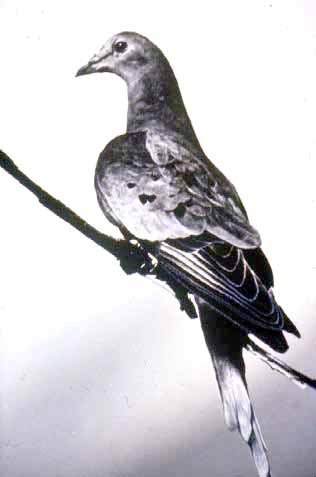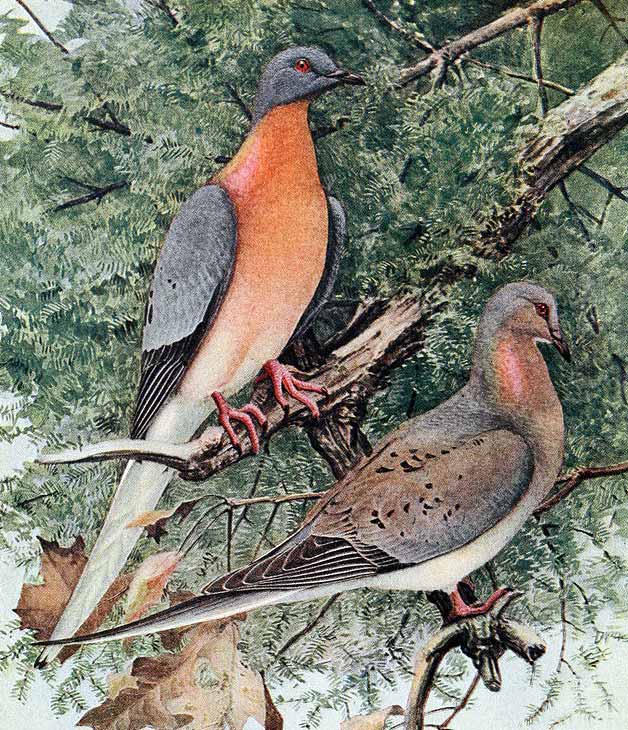The Passing of Our National (Extinct) Bird
One hundred years ago this month, a small gray pigeon with spotted wings became the most famous bird in American history. It achieved this distinction by one simple act — it died. And with it died the species Ectopistes migratorius. The passenger pigeon was no more.

The passing of a species is, of course, significant. But the loss of the passenger pigeon has taken on deeper meaning in our culture. The bird has become a symbol of what we have lost to time, a missing link to the wild abundance of early America. Other species — like the ivory-billed woodpecker and heath hen — have vanished, but they had not impressed Americans as the wild pigeon did with its endless flocks.
In the early 1800s passenger pigeons were so plentiful that when a flock passed over ornithologist John James Audubon, he heard the sound of “a hard gale at sea” and felt a surprising current of air from the beating of thousands of wings. As the birds came to roost, “a most magnificent as well as wonderful and almost terrifying sight presented itself,” said Audubon. “The pigeons, arriving by thousands, alighted everywhere, one above another, until solid masses as large as hogsheads were formed on the branches all round. Here and there the perches gave way with a crash and, falling on the ground, destroyed hundreds of birds beneath. … It was a scene of uproar and confusion.”
John C. French wrote in The Passenger Pigeon of Pennsylvania of a 2-mile-wide nesting ground stretching through 40 miles of unbroken forest near his Alleghany farm. Every morning pigeons would rise to fill the sky over a mile-wide valley, “eight courses deep at times, for about an hour, with the multitude of birds flowing westward, at the rate of about a mile a minute. … The roar of wings was like a tornado and the morning was darkened as by a heavy thunder shower.”
And yet, within a few decades, the passenger pigeon had become a rarity. As the 20th century began, the species was reduced to just a handful of birds being carefully tended by ornithologists.

Many Americans refused to believe the bird that had once crowded the skies from horizon to horizon was gone. Some were outraged when author and outdoorsman Emerson Hough made a passing comment in his June 4, 1910, Out-of-Doors column: “There have been no wild pigeons in America for many years.”
The comment prompted letters from Post readers who claimed to have heard about or personally seen flocks of passenger pigeons. Hough responded in October: “It is very surprising how general is the belief that the wild pigeon still exists in considerable numbers in different parts of the United States. Many newspaper stories announcing the ‘return of the pigeons’ appear. … Unfortunately they are not and cannot be true. The majority of the reports of wild pigeons … have come from writers who do not recognize the difference between the band-tailed pigeon and the passenger pigeon.” (“The Past Participle in Pigeons” October 15, 1910)
Hough left no room for argument or hope for a comeback.
He was just as adamant on a second point — humans were responsible for the extinction. His article added a new significance to the passenger-pigeon story. What had been a symbol of lost America was now considered a parable of American greed.
Hunters had assumed an endless supply, Hough wrote, and so slaughtered the pigeons without restraint. “In three years there were shipped from [Hartford] Michigan … 990,000 dozen pigeons — call it a million dozen, so you can remember it easily. They did not count them in less than dozens. This was from one part of one state alone. The town of Shelby, in Michigan, is said to have shipped a third more than did Hartford. It is said that in the heyday of pigeoning in Michigan, the town of Petosky shipped five carloads a day for 30 days,” which Hough calculated to be 14.8 million pigeons in one month.
“Everybody supposed that there would always be millions of them,” wrote Hough. “Everybody supposed that they must breed in immense numbers, six or eight young in a nest, at least. As a matter of fact, the bird was not prolific. It laid but one egg a year.”
Thirty years earlier, conservationists had warned commercial hunters of the inevitable end of this wasteful slaughter. But a Chicago wild-game dealer replied: “The pigeon never will be exterminated so long as forests large enough for their nestings and vast enough for their food remain. … The pigeon is migratory. It can care for itself.” Yet, Hough reported, the dealer’s shrinking supply of pigeon meat was already proving him wrong. The bird had practically disappeared the previous year, “almost at once.”
The suddenness of their passing was mystifying. Several readers wrote in to suggest the pigeons had simply migrated and forgotten to come home. There were no émigré flocks, Hough wrote. The birds had simply been slaughtered in a long frenzy of greed. Men had trapped them in nets, then dispatched them with clubs, boards, rocks, or pincers. Hough recalled one crazed trapper crushing birds’ heads with his teeth. “It was simply rapid butchery and that was all there was to it.” By 1883 they “had well-nigh finished their pretty work. … Fine — isn’t it? — what we practical, simple-minded Americans have done!” (“Regarding Martha,” June 21, 1919)

In 2014 we are accustomed to hearing warnings from conservationists and environmentalists. But 100 years ago, Emerson Hough’s ideas about preserving wildlife were relatively new, and unpopular. Readers often wrote him to complain of new and limited hunting seasons and expanded game preserves. Hough had no sympathy for them. He believed “future generations of Americans have been shamefully wronged by those who have preceded them.”
Throughout the early history of the United States, there had been little distinction made between ambition and greed. But years of “waste, extravagance, insatiate individual greed” as Hough expressed it, would eradicate valuable wildlife. Conservation was needed, he wrote, because, when Americans loved something, they tended to use it up. Given time, they would introduce everything they cared for to the past tense; not just passenger pigeons, but “our sports, our resources, our own country, our own species.”